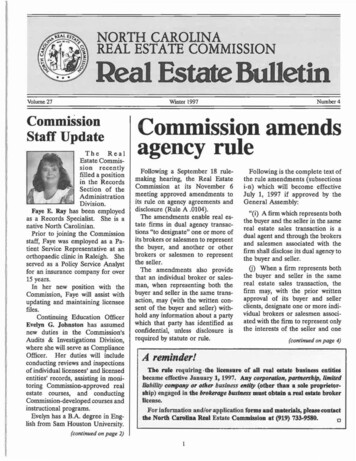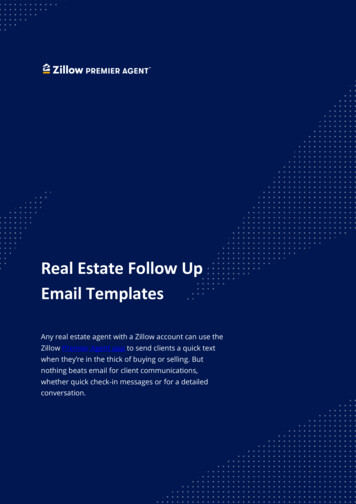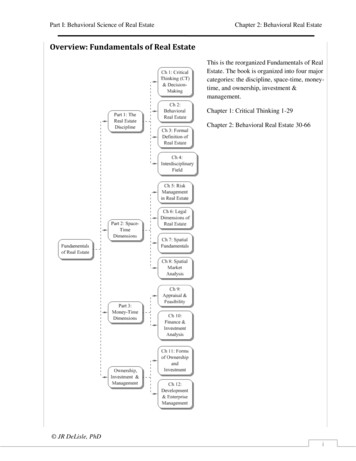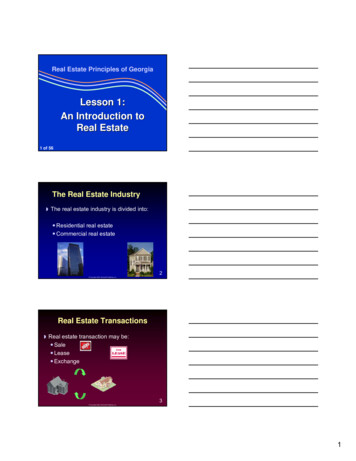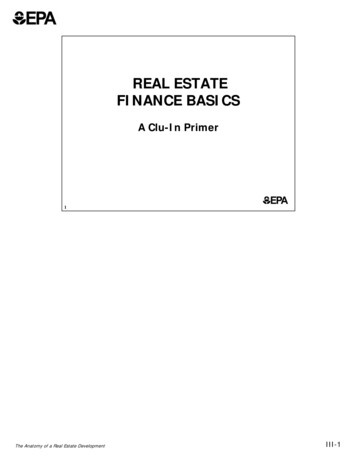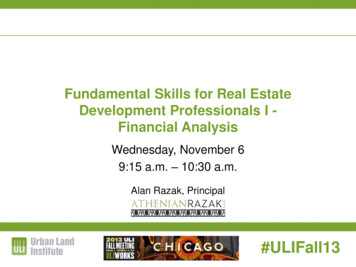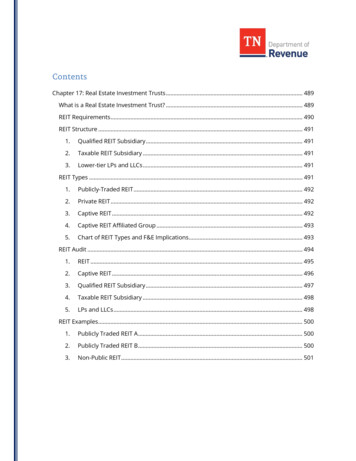
Transcription
ContentsChapter 17: Real Estate Investment Trusts . 489What is a Real Estate Investment Trust? . 489REIT Requirements . 490REIT Structure . 4911.Qualified REIT Subsidiary . 4912.Taxable REIT Subsidiary . 4913.Lower-tier LPs and LLCs . 491REIT Types . 4911.Publicly-Traded REIT . 4922.Private REIT . 4923.Captive REIT . 4924.Captive REIT Affiliated Group . 4935.Chart of REIT Types and F&E Implications. 493REIT Audit . 4941.REIT . 4952.Captive REIT . 4963.Qualified REIT Subsidiary . 4974.Taxable REIT Subsidiary . 4985.LPs and LLCs . 498REIT Examples. 5001.Publicly Traded REIT A . 5002.Publicly Traded REIT B . 5003.Non-Public REIT . 501
Chapter 17: Real Estate Investment TrustsWhat is a Real Estate Investment Trust?Real Estate Investment Trusts (“REIT”) own or finance income-producing real estate and aresimilar to mutual funds. They are tied to almost all aspects of the economy and allow smallinvestors to own a share in large-scale properties through the purchase of stock. REITs are usedin connection with owning and financing commercial properties, such as hotels, hospitals,industrial facilities, storage centers, shopping centers, warehouses, apartment complexes, officebuildings and timberlands.The two main types of REITS are Equity REITs and Mortgage REITs. 1 An Equity REIT generates income from the rental of property and gains when the realestate is sold for a profit. A Mortgage REIT invests in mortgages or mortgage securities tied to properties and itsprimary source of gross receipts is derived from interest and fees.REITs have a federal income tax advantage. Most corporations must pay taxes on their profitsand then decide how much to reinvest in the company and how much, if any, to return toshareholders in the form of dividends. Therefore, any dividends paid to the shareholders aretaxed at both the corporate and shareholder level. However, REITs are allowed to deductdividends paid in arriving at their net income subject to tax. To the extent a REIT pays its profitsout in dividends, it will not owe corporate income tax. The dividends paid deduction (DPD) allowsREITS to avoid duplicate taxation. Assuming all of the REIT’s profit is paid out in dividends, onlythe shareholders receiving dividends are taxed.REITS also have a Tennessee excise tax advantage. The starting point in computing net earningssubject to excise tax is the REIT’s federal taxable income before the net operating loss deductionand Section 857 deductions but after the deduction for dividends paid. If a REIT pays out all of itsprofit in dividends, it will not owe federal income or state excise tax.Some REITs are traded on major stock exchanges. Others are private or public non-listed. Thewebsite https://www.reit.com/ is a good source of information and has a directory of public andprivate REITS.489 P a g e
REIT RequirementsFederal tax law established REITs. REITs file Form 1120-REIT for federal income tax purposes. Toqualify as a REIT, per IRC Section 856(c)(1), the entity: Must be a corporation, trust, or association. Would otherwise be taxed as a domestic corporation. Must not be a financial institution (referred to in section 582(c)(2)) or a “subchapter Linsurance company.” Must adopt a calendar tax year. Must be managed by one or more trustees or directors. Must have beneficial ownership (a) evidenced by transferable shares, or by transferablecertificates of beneficial interest; and (b) held by 100 or more persons. (The REIT does nothave to meet this requirement until its 2nd tax year). Must derive 95% of its income from dividends, interest, and property income. Must derive 75% of its income from rent and mortgage interest. Must have 75% of its assets in real estate. Generally, the deduction for dividends paid (excluding net capital gain dividends, if any)must equal or exceed 90% of the REIT’s taxable income (excluding the deduction fordividends paid and any net capital gain).Note that there is a requirement for REITs to pay out dividends. To qualify as a REIT, an entitymust pay out at least 90% of its profits to investors as dividends. The dividends paid arededucted on Form 1120-REIT, Line 21b.Also, note that a REIT’s sources of income are predominately passive investments in real estate.A REIT cannot offer a complete range of services, like housekeeping or janitorial services, to itstenants without jeopardizing its status as a REIT. However, these services can be offered by ataxable REIT subsidiary (“TRS”), as discussed in the next section.490 P a g e
REIT StructureREITs are often part of a large organizational structure. They rarely operate alone as a singleentity. The types of entities that may be included in the organizational group include “qualifiedREIT subsidiaries” (“QRS”) and “taxable REIT subsidiaries” (“TRS”), in addition to lower tier LPs andLLCs.1. Qualified REIT SubsidiaryA QRS is a corporation that is wholly-owned by a REIT but is not itself a REIT. Generally, it is aholding company that does not have operations of its own. It is disregarded for federal incometax purposes and files with its parent on Form 1120-REIT. It is not disregarded for franchise andexcise tax purposes.2. Taxable REIT SubsidiaryA TRS is a corporation wholly-owned by a REIT, but it is not disregarded for federal income taxpurposes. The TRS and the REIT owner jointly make an election on federal Form 8875 2 to treatthe subsidiary as a separate taxable entity. A TRS files its own Form 1120 (not Form 1120-REIT).They are operating companies that provide services to tenants or third parties such ashousekeeping, landscaping, cleaning or concierge services.3. Lower-tier LPs and LLCsLower-tier LPs and LLCs are often the entities that own the real property and conduct businessoperations. Numerous pass-through entities may be created so each entity holds a single pieceof real estate. This is done for legal protection, loan restrictions, and to allow for differentownership groups. The pass-through entities may be entirely owned within the REIT group ormay have some owners outside of the REIT group.REIT TypesFranchise and excise tax auditors may audit taxpayers within the REIT structure without initiallyrealizing they are directly/indirectly owned by a REIT. When auditing a REIT or a REIT-ownedentity, the auditor should first determine the type of REIT at issue.There are three types of REITs under franchise and excise tax law that can result in different taxtreatments:491 P a g e
Public REIT; Private REIT; and Captive REIT.1. Publicly-Traded REITA “publicly traded REIT” is defined3 as one that has made the REIT election with the IRS, files withthe “securities and exchange commission” (SEC), and its shares are traded on a securitiesexchange that is either registered as a national securities exchange with the SEC or is a nationalsecurities exchange of a foreign country and regulated in a substantially similar manner by aforeign financial regulatory authority.Some REITs may appear to meet this definition, but fail to do so because they are traded on anover-the-counter (OTC) exchange or a private exchange.4 Also, just because they file documentswith the SEC does not mean they meet the definition; they could be filing in hopes of being listedin the future. An auditor may confirm if a REIT’s stock is publicly-traded on a national exchangeby going to https://www.reit.com/investor/explore and then entering the name of the REIT. Apage will name the exchange and where it is traded, if applicable. Generally, publicly tradedREITs are traded on the NYSE.2. Private REITPrivate REITs are not traded on national stock exchanges and are exempt from SEC registrationrequirements. These types of REITs generally only sell to accredited investors under RegulationD (under the Securities Act of 1933) or to Institutional Investors.3. Captive REITA “captive REIT” 5 is an entity that made the REIT election and is at least 80% owned, directly orindirectly (determined in accordance with GAAP), by another entity and whose shares are nottraded on a national stock exchange.492 P a g e
4. Captive REIT Affiliated GroupA “captive REIT affiliated group”6 (“CRAG”) is a captive REIT plus any entity in which the captiveREIT, directly or indirectly, has more than 50% ownership interest. However, a CRAG does notexist if the captive REIT is owned, directly or indirectly, by a bank, a bank holding company, or apublic REIT. Generally, a Captive REIT is closely held within, and by, an affiliated group, but notethat the law excludes bank-related REITs from being classified as a CRAG.Captive REITs historically used the DPD in order to mitigate taxation as a state-level tax planningstrategy. A Captive REIT would own a partnership or LLC that had business operations. Thelower-tier partnership or LLC would incur operating expenses, so they usually had little netincome, and the Captive REITs had no taxable income due to the DPD.However, beginning July 1, 2010, the DPD effectively is no longer available for a Captive REIT,unless it is owned, directly or indirectly, by a bank, a bank holding company, or a public REIT.While the Captive REIT group can deduct the DPD to compute its federal taxable income onSchedule J4, Line 2b, it must add it back on Schedule J, Line 14, thus negating the DPD deduction.Because of this, the Captive REIT group may incur an excise tax.75. Chart of REIT Types and F&E ImplicationsThe first step in auditing a REIT or REIT-owned affiliate is to determine if the REIT is public,private, or captive. This is important for the reasons shown in the following chart.493 P a g e
TypePublic REITPrivate REITREIT AttributeReceive DPDReceive DPDCaptive REIT(by definition, arenon-public)No DPDSch. J4 allows theDPD, but it isadded back on Sch.J; so, net is -0-Captive REITowned by a bank8Receives DPD. Theadd-back of DPDon Sch. J is notmade.Captive REITowned by a publicREITReceives DPDFile FAE 170File FAE 170File FAE 174 combinedwith the CRAGaffiliatesFiles like any othersubsidiary of an FI onFAE 174. This is not aCRAG.9This is not a (CRAG)because the owner is apublic REIT. Files onFAE 174 because it is aCaptive REIT, but notcombined with lowertiers.Owned Pass-ThruLPs, LLCs owned by apublic REIT adjustSch. J1 by amountsincluded on the K-1they issue to the REITLPs, LLCs owned by anon-public REIT donot adjust Sch. J1 foramounts the LP, LLCdistributes to a nonpublic REIT via a K-1LP, LLC, QRS, TRS 50%-owned arecombined on FAE 174return. The J1 line“distributed to apublic REIT” wouldnot apply.LPs, LLCs areincluded in FAE 174 ifthey meet definitionof FI at TCA 67-4-2004LPs, LLCs are notincluded in theFAE174, since this isnot a CRAGREIT AuditThe rules discussed in earlier chapters concerning disregarded entities, substantial nexus,separate entity reporting, and Schedule J add-backs and deductions generally apply to REITs,their subsidiaries, and lower-tier entities.10 The following paragraphs will discuss only franchiseand excise tax issues and audit tips that are unique to REITs and their affiliates, including thecombined filing requirement for captive REIT affiliated groups and conclusions reached in494 P a g e
Revenue Ruling 13-22, concerning an LP owned by a public REIT that is federally disregarded andfiles on the REIT’s return.It is possible to audit an LLC or LP and not be aware that it is directly or indirectly owned, tosome extent, by a REIT. So, an initial step in any audit is to obtain an expanded organizationchart that would show any REIT ownership. If there is a REIT in the organizational tree, theauditor must determine if it is a public, private, or captive REIT, as defined earlier.1. REITAll REITs are corporations.11 REITs file on Form 1120-REIT and deduct the amount they pay individends in determining their federal and state taxable income. The DPD may only be taken bythe corporation that has made the federal REIT election under I.R.C. § 856(c)(1). The deduction isnot allowed for anyone other than the actual REIT that made the IRS election.Often, the REIT itself is not subject to franchise and excise tax because its only connection withthe state is its ownership interest in lower-tier entities that are “doing business” in the state. Thisownership of limited liability affiliates would not create nexus for the REIT. However, even if theREIT has nexus in Tennessee, it would generally report little or no taxable income because of theDPD. Also, the franchise tax base generally would not reflect the book value of real estatebecause it is usually owned by lower-tier entities. In addition, the net worth amount would bediminished because of the required dividend payments (90% of income).Audit Tips Request an organization chart and determine if the 80% ownership test of a captive REIThas been met. See the next section if the REIT is a Captive REIT. Identify the REIT’s direct and indirect affiliates. Consider if the lower-tier entities should berecommended for audit. If applicable, ask for a pro forma federal return that does not include any QRSs, since theyare always required to be included in the federal Form 1120-REIT. Schedule J4, Line 2a is from Form 1120-REIT, page 1, Line 20 – “Taxable income before DPDand other deductions.” Schedule J4, Line 2b is from Form 1120-REIT, page 1, Line 21b –“Deduction for dividends paid.” REITs are unique in that they are allowed to deductdividends paid. SMLLCs owned 100% by a REIT are disregarded since a REIT is a corporation.12495 P a g e
2. Captive REITA CRAG is an exception to the general franchise and excise tax rule concerning separate entityreporting. A CRAG files on a combined basis on Form FAE 174.13 On the following page is anorganization chart of a captive REIT. Since the REIT is owned at least 80% by another entity, it is acaptive REIT. The group includes the captive REIT and all entities in which the captive REIT has adirect/indirect ownership interest of more than 50%. The captive REIT, QRS, and Acme LP wouldreport their activities on a single Form FAE 174. Schedule J4 would reflect the combined netincome of the group and would include the DPD. However, the DPD add-back on Schedule J willnegate the deduction.ABC Corp.ABC Corp’s.Affiliate20%80%Captive REIT Group 1 FAE174, no DPDCaptive REIT100%XYZ Corp.QRS75%Acme LP25%The CRAG’s taxable net earnings are the combined net earnings/losses for all members of theaffiliated group (all dividends, receipts, and expenses resulting from transactions between496 P a g e
members of the affiliated group are excluded), subject to the Schedule J add-backs/deductions,14even if some of the members would not be subject to the excise tax if they were not part of theaffiliated group.15The net earnings of the CRAG are apportioned to Tennessee based on the standard 3-factorformula16 (dividends, receipts, and expenses between members of the group are excluded). Thefactors include values for group members that would not be subject to the tax, had they notbeen designated as CRAG members. The apportionment ratio is calculated on Form FAE 174,Schedule N – Apportionment – Captive REITS.17Audit Tips – Captive REIT and CRAG Obtain an organization chart and determine if there is a captive REIT present.-IRS REIT election was made-80% or more of REIT is owned by another entity that is not an FI or public REIT-REIT is not publicly tradedDetermine if the captive REIT is owned directly/indirectly by a bank, bank holding companyor a public REIT. If this is the case, a CRAG does not exist. See chart above for filingrequirement. Determine that the correct affiliates are combined on Form FAE 174. (REIT has adirect/indirect ownership 50%). Verify that the group’s combined net income, net of the DPD, is reported on Schedule J4of Form FAE 174. Verify that the DPD is added back on Form FAE 174, Schedule J, negating the DPDdeduction;18 unless the captive REIT is owned by a bank or a public REIT.3. Qualified REIT SubsidiaryThese corporations are wholly-owned by the REIT and are disregarded for federal income taxpurposes, but not for franchise and excise tax purposes.Audit Tips – QRS497 P a g e
Auditors should ask for a pro forma federal return reflecting just the QRS’s activities, sincethey are always disregarded to their parent’s Form 1120-REIT. A taxpayer may report the QRS’s separate entity activity on a pro forma Form 1120-REIT.However, the DPD should not be allowed for excise tax purposes. Just because a Form1120-REIT was used as a pro forma does not mean the DPD should be allowed. A QRS isnot a REIT, and therefore, is not allowed the DPD.19 Form FAE 170, Schedule J4 is the excise tax starting point, unless it is a CRAG affiliate. A QRS may be owned by a captive REIT and included in the CRAG’s combined return, FormFAE 174. See previous diagram.4. Taxable REIT SubsidiaryThese corporations file on Form 1120 and will not be included on a federal Form 1120-REIT.Audit Tips – TRS Audit procedures are the same as those done in any corporate audit. The DPD is not allowed, since it is not a REIT. A TRS may be owned by a captive REIT and included in the CRAG’s combined return, FormFAE 174.5. LPs and LLCsLower-tier entities may be directly or indirectly owned by a REIT. The following discussion appliesto LPs and LLCs that are owned by a REIT, but not a captive REIT.20 There are adjustments onForm FAE 170, Schedule J1 unique to REIT-owned pass-through entities.21 Thes
Chapter 17: Real Estate Investment Trusts What is a Real Estate Investment Trust? Real Estate Investment Trusts (“REIT”) own or finance income-producing real estate and are similar to mutual funds. They are tied to almost all aspects of the economy and allow small investors to own a share in large-scale properties through the purchase of stock.


